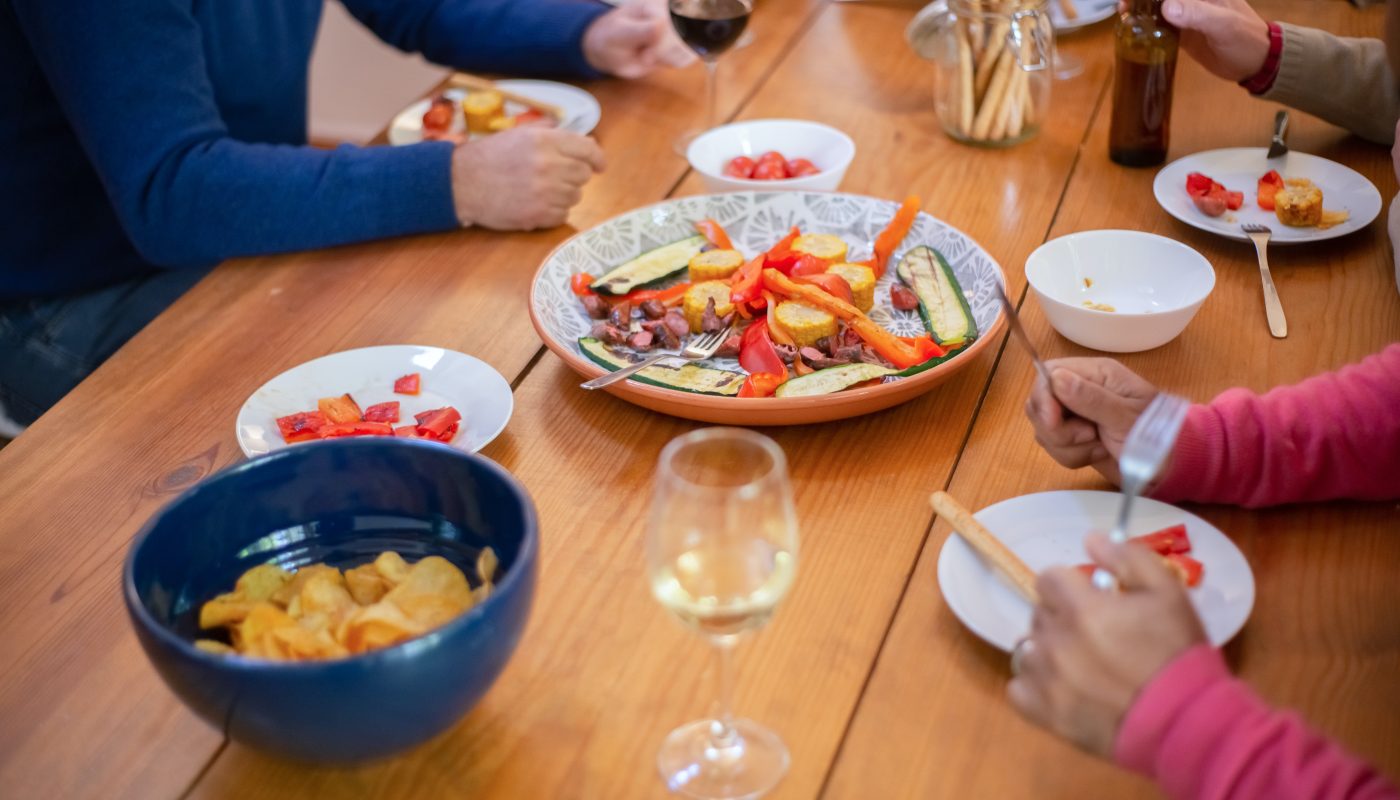Sustainability and “sustainable systems” have become buzzwords—and for a good reason. They’re often discussed in conjunction with climate change, a real issue facing the entire world.
Data shows 2021 was the sixth warmest year on record. Scientists say the warming temperature intensifies rainfall and changes habitats for plants and animals—including people.
The United Nations estimates that climate-related disasters force about 20 million people worldwide from their homes.
Sustainable (or electric) cars and eco-denim have all become buzzy in the auto and fashion industries. In the dining and wellness sectors, sustainable food has become a common refrain. What, exactly, does that mean?
“By definition, sustainable eating refers to diets with little environmental impacts, improve food security and nutrient density, and add to the health of present and future generations,” says Trista Best, a registered dietitian at Balance One Supplements.
It sounds like a great idea — and plenty of data suggests that sustainable habits, particularly dietary, can have an impact. For instance, food systems are responsible for one-third of greenhouse emissions, indicates a 2021 reportTrusted Source.
If we, as individuals, can choose food that doesn’t contribute as much to it, it can make an impact. But it’s not that simple — there are systems at play.
“As nice as it would be to simply define sustainable eating as eating well for the planet, the reality is that it’s a variable and nuanced term depending on who you’re talking to and the circumstances at play,” says Cara Harbstreet, a registered dietician of Street Smart Nutrition.
Still, knowing about these systems can help people make informed decisions, such as purchasing products from sustainable brands at the grocery store.
Below, Harbstreet and others explain sustainable eating, plus suggestions for implementing sustainable habits into your diet in realistic ways.
What is sustainable eating?
“Sustainable eating is simply a dietary pattern that considers both the body and the environmental impacts,” Best says. “This pattern seeks the least negative effects on both and food sources that improve health and the environment when able.”
Heather White, environmental science expert activist, author, and founder of the nonprofit One Green Thing, explains that sustainable eating involves the evidence-based idea that how our food is grown and what we consume impacts the environment.
“A key tenant of ecology is that everything is connected — our water, air, food, soil, and our personal health,” White says.
For example, a study published in 2022 analyzed greenhouse gas emissions in the U.S. from 2003 to 2018. Their research suggests that a reduction in beef consumption accounted for a 50 percent reduction in greenhouse gas emissions.
But so much of it goes beyond individual choices and Mother Nature’s beef with beef. Agricultural practices play a role in our ecosystems — it’s ecology.
White says some of these practices include:
- chemicals and fertilizers
- transportation of food, such as traveling long distances in carbon-emitting vehicles
- food packaging
- water use
Research from 2022Trusted Source indicated that food transportation accounted for nearly one-fifth of food systems emissions.
A 2020 reviewTrusted Source suggested that plastic food packaging can affect the environment and even human health through exposure to chemicals like Bisphenol A (BPA) and phthalates, which have been associated with increased risk of obesity, cancer, and diabetes risks.
A 2020 systemic review and meta-analysisTrusted Source indicated that 70 percent of freshwater is used for agriculture (food and non-food) globally.
“From an ecological and agricultural standpoint, these numbers are unsustainable and will only grow if something isn’t done to reverse them,” Best says.
Benefits of sustainable eating
Research and experts share that sustainable eating habits might:
- reduce environmental impacts of food, notably greenhouse gas emission
- improve individual health outcomes
- Influence agricultural practices
- empower consumers
Recent research shines a light. A 2022 study of 57,000 food products sold in the United Kingdom and Ireland indicated that lamb and beef had the most significant environmental impacts, while produce and grains had the lowest impact.
A 2020 review of 18 studies indicated that sustainable diets led to positive health outcomes for people and reduced greenhouse gas emissions. The research did not indicate a reduction in water use. A 2018 paperTrusted Source concluded that agriculture has the biggest role in greenhouse gas emissions, but human dietary habits could significantly affect food production.
Plant-based diets are often at the center of sustainable eating habits. Though vegetables have to get transported, a 2014 study suggests that vegetarians and vegans contributed half as many dietary emissions as individuals who ate animal protein.
A 2019 systemic reviewTrusted Source of more than 25 studies that included participants who were either healthy, obese, or had type 2 diabetes indicated “robust evidence” that plant-based diets had short and moderate-term effects on:
- weight
- energy metabolism
- inflammation
A 2021 reviewTrusted Source indicated that human and global health could significantly improve by swapping animal-based foods like meat and eggs with plant-based alternatives. But the authors acknowledged hurdles, including social and economic ones. Best says plant-based diets are nutrient-dense and lower in fat and calories.
Besides health outcomes — for people and the environment — experts share that sustainable eating habits can feel empowering and make a statement.
“[Benefits] include greater consciousness and awareness of where food comes from, which can lead to feeling more confident and empowered about food choices,” Harbstreet says. “Sustainable eating can also feel better aligned with our personal values, allowing us to embody what’s most important to us by way of what we eat.”
White agrees.
“The benefit of sustainable eating is that you are voting with your wallet,” White says, referring to the more environmentally-friendly practice of these products.
How to eat sustainably
You can’t completely overhaul the agricultural system overnight, but you can make small tweaks to your eating habits. If you’re looking for how to eat sustainably on a budget, there’s good news: Not every food habit change comes with a hefty price tag. Experts shared ways to implement sustainable food practices at home.
Eat more plant-based foods
The research indicates that diets rich in plant-based are better for the environment and can improve health outcomes, too.
“Certain foods like beef and lamb take a lot of carbon to create,” White says.
But she says you don’t have to become vegetarian or vegan. She suggests adopting a plant-based diet once per week, such as on Meatless Monday.
Meal plan and prep
The FDA estimatesTrusted Source that food waste makes up 30 to 40 percent of the food supply. One way to cut back on that is to plan meals for the week in advance so you purchase exactly what you need. Then, prepare the foods — and be mindful of expiration dates.
“Use up the perishable items first before moving on to the more shelf-stable ones,” Katie Krejci, MS, RD, LD, IFNCP, a registered dietician.
As you’re prepping (and consuming) food, Krejci suggests implementing a nose-to-tail sustainable eating plan. Sustainable food recipes look to make use of more than parts of an animal, like the wings and breasts.
“In today’s culture, we are used to only eating a few cuts of meat,” Krejci says. “This leads to a lot of waste. Learn how to use things like chicken feet, gizzards, beef tongue, or ox tail. Save the bones to make your own bone broth. Render down fat from grass-finished/pasture-raised animals to save for cooking later.”
White suggests freezing leftovers.
Compost food scraps
The Environmental Protection Agency (EPA) lists composting as part of its food recovery hierarchy, a number of actions that prioritize reducing food waste.
Krejci says composting food scraps and then re-using them as garden fertilizer is a win-win. Some localities also have locations where you can drop compost.
“A compost pile can be as simple as a pile behind your garage or as complex as a tumbler or bin,” Krejci says. “They even made countertop models for those in apartments.”
Eat seasonally
Strawberry season is typically June in many parts of the U.S., but you can still buy them in December.
“That’s only because it’s been shipped from halfway around the world,” Krejci says.
She suggests prioritizing seasonal items. This might look like:
- long-storage and cold-tolerant items in cooler months (potatoes, carrots, and onions)
- fast-growing, cold-tolerant produce in the spring (asparagus, cabbage, and lettuce)
- berries, tomatoes, and squashes in the summer
Local farmers can give you a better idea of what is in season in your area.
Try the 100-mile diet
Eating local can reduce the carbon footprint of your food choices. White concedes this doesn’t work for everyone and that social and economic factors play a role. But if possible, she suggests considering what’s known as the “100-mile diet,” which means purchasing produce from farmers within a 100-mile radius of where you live.
She says the benefits of this sustainable food idea include:
- reducing transportation costs and environmental impact
- supports sustainable eating habits and agriculture (ask your farmer about their sustainable food production practices)
- supports the local economy
Krejci says local farmers’ markets are a great way to meet producers and growers from your region without straying more than a couple of miles from home.
Join a CSA
Before food subscription boxes, there were Community Supported Agriculture (CSA) programs, and Krejci recommends looking into one. CSAs allow you to purchase “shares” of farm-grown and raised products,” so you’ll get everything from produce to milk, eggs, and meats. Krejci says you can look for CSA opportunities through localharvest.org.
“Make sure that they are using organic methods and that their animals are grass-finished or pasture-raised [or both],” Krejci says.
Grown your own food
Gardening lets you know exactly where your food came from and what practices, such as irrigation and fertilizers, were used.
“You don’t even need fancy raised beds to grow food,” Krejci says. “Simply turn over your grass with a shovel, add some compost, and you’ll be ready to go.”
And garden gives you the opportunity to implement another sustainable eating habit. Krejci suggests canning and saving produce for winter when there’s less in season.
Use sustainable food packaging
A 2021 studyTrusted Source indicated that replacing single-use packaging with reusable packaging, such as food containers and carrier bags, would reduce emissions by 63 percent. Best believes using reusable grocery bags, swapping plastic sandwich bags for reusable containers, and storing food in reusable containers can reduce your carbon footprint.




